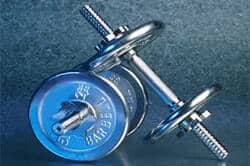Building Muscle After 60

Some people believe a common myth that, after age 60, the human body is unable to build muscle. The fact is, according to Dr. David Heber, director of UCLA’s Center for Human Nutrition, new research published in the journal Medicine & Science in Sports & Exercise finds older adults who begin lifting weights after 50 may win the battle against age-related muscle loss.
“You have to do what we call resistance exercise,” Heber says. “It could be lifting weights, it could be stretchy bands, but the key is you have to stretch a muscle.”
Building muscle is all about stretching a muscle to the point of straining it. At that point, you set in motion the body’s natural muscle-building response. The muscle is strained, so it prepares itself for the next strain by building itself up. In this way, muscles build fiber and actually increase in size.
Sandy Palais, 73, of Tempe, Arizona, who does resistance training six days a week for about an hour each day, started lifting weights about 10 years prior, shortly after she was diagnosed with osteoporosis. Weight training builds both muscle and bone mass. Palais started going to the gym three days a week. It didn’t cost much, and student trainers were there to help. Within a year, she was able to compete in the local senior Olympics.
“My top score was 380 pounds,” she laughs. “I squatted 135. I benched 80. And I deadlifted 165.”
Exercise physiologist and researcher Mark Peterson first met Palais when he was a student trainer at Arizona State University. Now, Peterson works at the University of Michigan where he authored the new research published in Medicine & Science in Sports & Exercise that looked at whether older people can reverse the process of muscle loss.
“The time in which we say that older adults can’t do more exercise is long gone,” he says.
In Peterson’s analysis of 39 studies, he found that among more than 1,300 adults over the age of 50, muscle mass could be increased by an average of nearly 2.5 pounds in just five months. The greater the intensity of weight-lifting programs, the more dramatic the outcomes. Adults who lifted the most weight boosted their upper and lower body strength by nearly a third.
So, is resistance exercise just for those seniors who want big muscles? No! Muscle strength and balance help prevent falls, one of the most common reasons seniors end up in the hospital.
For sedentary adults who resolve to take up weight lifting, Peterson suggests starting slowly. You could actually begin by simply getting in and out of a chair. He says the ability to stand up out of a chair is much compromised after the age of 65 if people don’t take part in resistance training. So, using one’s own body mass as a dead weight is a “reasonable way to start.”
And, after exercising, don’t forget to eat, adds Heber. If you don’t, muscles could actually get beaten down and not have the building blocks to get bigger and stronger. Protein is essential, Heber says, adding that your best bets are chicken, fish, soy, beans and nuts like pistachios, walnuts and almonds.
Check with your doctor before beginning any new exercise regimen.
Source: www.npr.org



